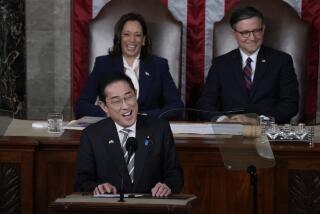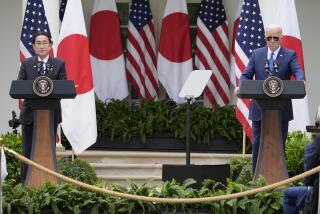Clinton Would Yield Some Turf but Seek to Retain Troop Levels in Asia
- Share via
WASHINGTON — Behind the scenes, there is a serious debate underway in Washington over the future of the American military presence in Japan and the rest of East Asia.
The debate has been propelled by the rape case in Okinawa last fall, in which three U.S. servicemen are awaiting sentencing for an attack on a 12-year-old Japanese schoolgirl, and by the outpouring of anger by Okinawans over that incident.
The questions being asked are far-reaching. Does the United States need to keep 100,000 troops in Asia? What are they there for? Should some of them be brought home? To what extent does America still need all of the extensive military facilities built up in Japan during the Cold War?
It appears that the Clinton administration has quietly developed a strategy to answer such questions. President Clinton brought it to his recent meeting with Japanese Prime Minister Ryutaro Hashimoto in Santa Monica, and the president will make it public during his trip to Japan next month.
Clinton’s formula is this: Trade away land for numbers. Give back some of the turf American troops now occupy in Japan, perhaps even whole bases, but by all means keep the American troop strength at current levels.
At the moment, the Pentagon is quietly preparing what will be, from one perspective, some of the most extensive changes in the American military presence in Japan in decades.
Large chunks of land now occupied by the American military, it appears, will be given back to Okinawa. American military operations in Okinawa--flights, training, live-fire exercises--will be curtailed.
Yet from a broader perspective, these changes will be aimed at preserving the status quo: the continuing presence of about 47,000 American troops in Japan. About 27,000 of these forces are stationed in Okinawa.
Clinton likes to portray himself as a forward-looking, dynamic leader. Yet the record shows that when it comes to the American military presence in Asia, Clinton has proved to be more resistant to change than was the Bush administration.
In the early 1990s, before Clinton took office, the Pentagon was planning to reduce American troop strength in Asia gradually through this decade. But the Clinton administration reversed course by announcing, in what the Pentagon calls the “East Asia Strategy Report,” that the United States will maintain American troops in Asia “for the foreseeable future” at the 100,000 level.
Of course, that Pentagon policy was set down before the Okinawa rape case. Since then, tens of thousands of Okinawans have turned out for demonstrations against the American military bases there, and the Okinawan government has formally called for the closure of all U.S. bases on the island by the year 2015.
Yet in the wake of the Okinawa incident, the administration is still playing by the numbers: It insists that what counts is preserving the troop strength at current levels.
After the meeting in Santa Monica, Assistant Secretary of State Winston Lord immediately announced that the president told the Japanese prime minister “that we intend to maintain roughly our current levels of forces in the Pacific and in Japan.”
Why does the administration have such a fetish about the numbers?
Some U.S. officials point to the need for troops as reinforcements in case war breaks out on the Korean peninsula. Yet that threat seems increasingly remote. North Korea is growing economically weaker month by month, to the point where it’s not clear it can even count on feeding its troops or putting fuel in its planes.
Others point (always gingerly and euphemistically) to the need for U.S. troops in Asia to counteract China’s growing power. But that seems like a contradiction: Officially, administration officials--from Clinton and Defense Secretary William J. Perry on down--have repeatedly insisted that the United States does not see China as a threat, and that it is not U.S. policy to try to contain China.
The real reason seems to be sheer symbolism: The administration has decided that keeping 100,000 troops in Asia, including the 47,000 in Japan, is necessary to show other Asian governments that the United States is not withdrawing from Asia and is, in fact, determined to remain an Asian power.
“A lot of Asians, including a lot of Japanese, believe we are pulling out from Asia,” observed Stanley Roth of the U.S. Institute of Peace, who until December was in charge of Clinton’s Asia policy for the National Security Council.
“They see Clinton canceling a trip to Asia, they see the United States closing consulates and they say the Americans are shutting down. To take troops [in Japan], the only ground troops we have for area-wide contingencies, and pull them back to California and Hawaii would be taken in Asia as evidence of a U.S. withdrawal.”
Critics say the troop strength has become a symbol of America’s commitment to Asia only because the Clinton administration made it so. “We’re defining our strategy strictly in terms of numbers,” said Mike Mochizuki of the Brookings Institution, who argues that the United States can and should remove 20,000 Marines from Okinawa because they are no longer needed in Asia.
Clinton’s hold-the-numbers Japan policy is being questioned by a curious amalgamation of forces. In general, his critics can be divided into two groups: revisionists and Republicans.
The revisionists include those who have been criticizing America’s Japan policy for years, largely on grounds that it perpetuates unequal trade and economic ties between the two countries, turning Japan into a U.S. protectorate and American troops into mercenaries.
“As far as Japan’s Ministry of Finance is concerned, contributing $5 billion to the upkeep of U.S. troops in Japan is a budgetary windfall; it would be far more costly for Japan to finance its own defense,” wrote Chalmers Johnson and E. B. Keehn in the journal Foreign Affairs last year.
Some Republicans criticize Clinton’s policy for different reasons, relating to security rather than economics.
They want to strengthen the military alliance between the United States and Japan--in the process, having Japan take on more of its own defense. And they argue that what counts is not how many troops are stationed in Japan but what military roles and missions they perform.
“Any administration should keep as much flexibility as possible,” argues Richard L. Armitage, former assistant secretary of defense and a close associate of former chairman of the Joint Chiefs of Staff Colin L. Powell. “If we had to move 5,000 to 10,000 troops out of the region, I wouldn’t want it to be seen as a loss of affection for Asia.”
The furor over Okinawa seems to have put Japanese leaders into a quandary. Hashimoto’s performance at the Santa Monica meeting perfectly captured Japan’s current ambivalence.
In public, Hashimoto came on strong. He told a news conference that he had asked Clinton’s help in “realigning, consolidating and reducing U.S. bases on Okinawa.”
He placed far greater stress on Okinawa, and the American bases, than did U.S. officials.
Yet in the private meeting, Hashimoto is said to have told Clinton that he is eager to rebuild Japan’s defense ties with the United States, which he described as even more important to Tokyo now than they were during the Cold War.
The interesting question to watch is whether Japan will endorse the Clinton administration’s idea that America’s troop strength in Asia should be kept indefinitely at current levels.
Before a Tokyo meeting that Clinton was scheduled to attend in November, Japanese officials had agreed to sign a draft communique that accepted the American commitment to maintain 100,000 troops in Asia indefinitely. Yet U.S. officials admit that it wasn’t easy to get Japan to agree to the idea.
Ensnared by Washington’s budget battles, Clinton canceled that trip to Tokyo, and the draft communique was never signed. Now that the president is planning to visit Tokyo in April, it’s not clear whether Japan is willing to agree to preserving the same number of U.S. troops in Asia forever.
Clinton’s Japan policy echoes the writer Thomas Wolfe: None of our troops can ever go home again. It’s not clear yet how this novel idea will sell in Japan.
The International Outlook column appears here every other Monday.
More to Read
Sign up for Essential California
The most important California stories and recommendations in your inbox every morning.
You may occasionally receive promotional content from the Los Angeles Times.









